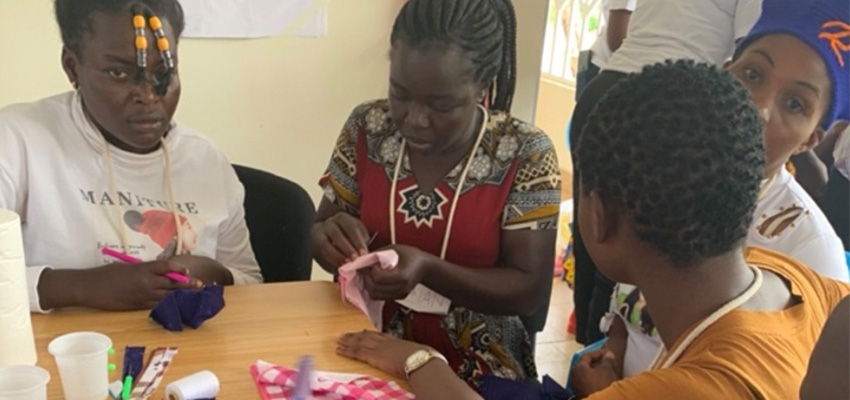
After taking the D-Lab: Gender and Development class in Fall 2021, I traveled to Oyugis, Kenya for the implementation of a menstrual health curriculum we had developed through the class.
The class: D-Lab: Gender and Development
As an architect, I became fascinated with the different experiences that men and women have with the same design meant to serve them and wanted to further explore society perceived through the gender lens. It was this desire that led me to enroll in D-Lab: Gender and Development during my first week at MIT. The class struck a delicate balance between theory and practice due to the incredible professors teaching the class: Professor Sally Haslanger, Ford Professor of Philosophy and Women’s and Gender Studies, and Libby McDonald, MIT D-Lab Inclusive Economies Specialist. In line with this theme of theory and practice, students in the class had the opportunity to be involved in field projects relating to gender equity.
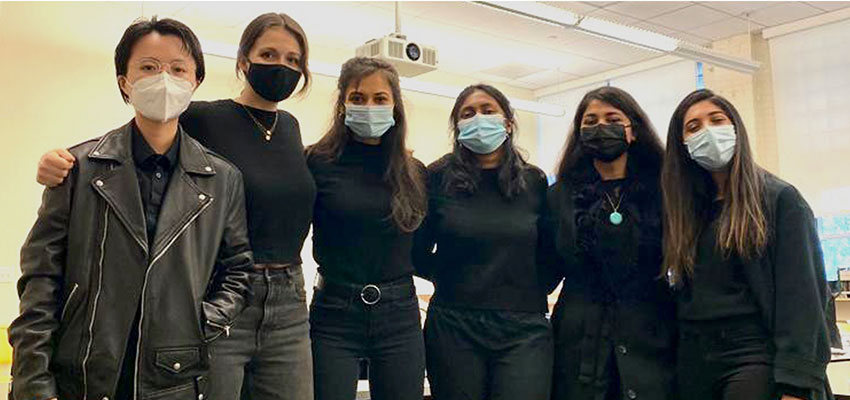
The field project: a sexual and reproductive health curriculum based on D-Lab's Creative Capacity Building model
The field project I became involved with was to develop a sexual and reproductive health curriculum based on D-Lab's Creative Capacity Building (CCB) model, which promotes community driven innovation. We partnered with the Society Empowerment Project (SEP), a community-based organization in Oyugis, Kenya that focuses on empowering youth and promoting community development. One of the societal issues they aim to address is sexual reproductive health and menstrual hygiene management. Starting in the class and continuing through Spring 2022, we worked closely with Festus Juma, Founder and Executive Director of SEP, and Lourraine Chess, Health and Education Programs Manager of SEP, to understand the needs of the community and navigate on-the-ground logistics.
This curriculum was designed for young girls both in and out of school to be carried out over the course of five days for a few hours each day. Given this time constraint, the team decided to focus specifically on menstrual health and hygiene. The curriculum consisted of hands-on activities to engage the participants, build-its for skill building, and a team project to teach girls about menstrual health and create an environment to empower them to address challenges they face individually and as a community. Following the CCB model, the groups would identify problems they faced and prototype solutions to address those challenges. After the class, a few students from the team continued to develop the curriculum along with our professors and Sher Vogel, MIT D-Lab Global Trainings Manager.
Training the trainers
The final curriculum was to be implemented in four sessions – two for students in primary school, one for students in secondary school, and one for girls out of school. Arshaya Sood, my fellow Kenya team member from the class, went to Oyugis to train the trainers and help facilitate the first session. You can read all about her experience *here.* Before I arrived in Kenya, I had the benefit of learning from Arshaya’s experience and the improvements she and Faith made to the curriculum. It required a lot more detail to ensure the local trainers had all the required information to carry out the workshop and understood the intent of each exercise. The actual time we had with students was less than anticipated so the curriculum also needed to be shortened.
In Kenya
I arrived for the third workshop, which was for students no longer in school. Having never been to Kenya before, I relied heavily on Arshaya’s recount of her experience from a couple weeks prior and am so grateful to have been able to build off her experience. Oyugis is a rural town in Homa Bay County on the west side of the country. From Boston, it required two long flights, a night in Nairobi, a short flight to Kisumu, and then a two-hour drive to Oyugis. Festus met me at the airport in Nairobi and served as the best company as we made our way to his home in Oyugis on Sunday night.
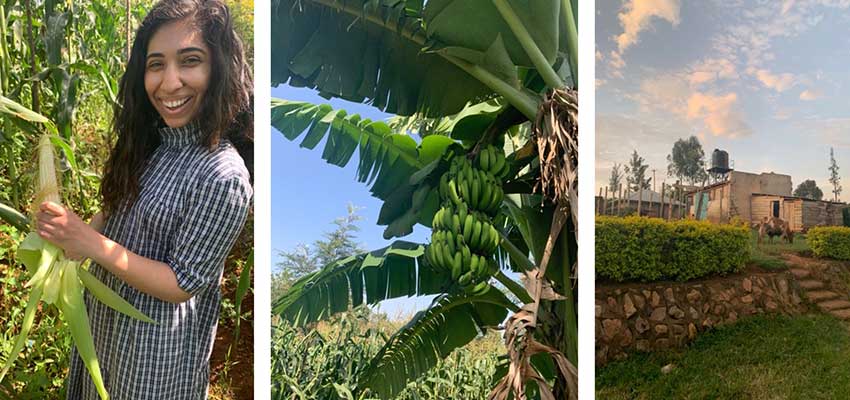
Festus and Lourraine’s home is situated on a compound surrounded by animals grazing and fields. I woke up to a rooster crowing, met the rest of the family who were so welcoming and kind, and explored the grounds. Growing up in a south Asian family, the food I had in Kenya felt very familiar to that cuisine even if specific ingredients were unique to the region. I even had some of my favorites – chai, chapati, and samosas!
The workshop
Given that there were a lot of changes made to the curriculum, I had a bit of studying to do to prepare myself for the workshop. This was the third workshop for the trainers and the first one for me and I was so impressed with the confidence and skill the trainers brought to the workshop. It was truly amazing seeing this thing we’d been working on in class, through google docs, and zoom meetings come to life.
This workshop was for girls who were no longer in school, either having graduated or having left due to a pregnancy or other reason. Many were mothers and brought their young children to the workshop. Unlike the other workshops that had been hosted at the school, this one was hosted at the SEP office. From day one, we quickly realized that most participants were more comfortable speaking in Swahili so most of the sessions were conducted in Swahili or in combination with English. Although I picked up some Swahili, I was by no means fluent. I focused on further editing the curriculum for clarity with Faith Kathoka, a program associate at the World Food Programme in Nairobi. Faith had experience with D-Lab's design approach through an International Development Design Summit (IDDS) in 2019 (see Faith's D-Lab blog post That life-changing summit: IDDS) and brought a lot of practical insight to this curriculum.
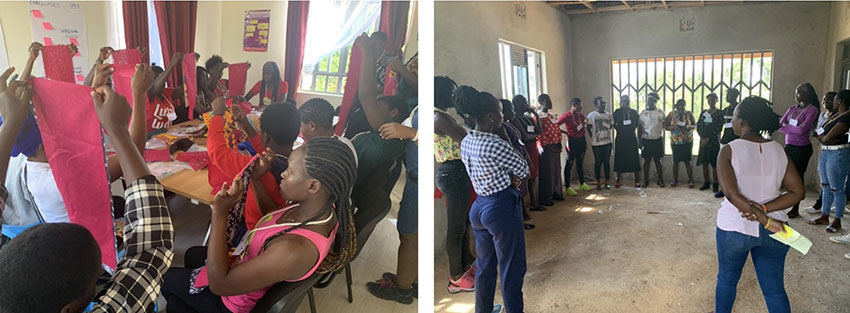
Throughout the workshop, I learned so much from the participants and the trainers – each had their own powerful story to tell and their strength and resilience served as inspiration. A key part of the workshop was the Story of Self, Us, and Now and we learned about menstrual health struggles that were so prevalent in the community. The two problems that participants identified were the lack of knowledge about this topic (how to use a pad, where to get it from, basic hygiene during menses), and barriers to obtaining menstrual products. For the CCB design cycle, the participants decided to tackle these two issues in their smaller groups by designing a poster with menstrual health and hygiene information and pads (both reusable and single use).
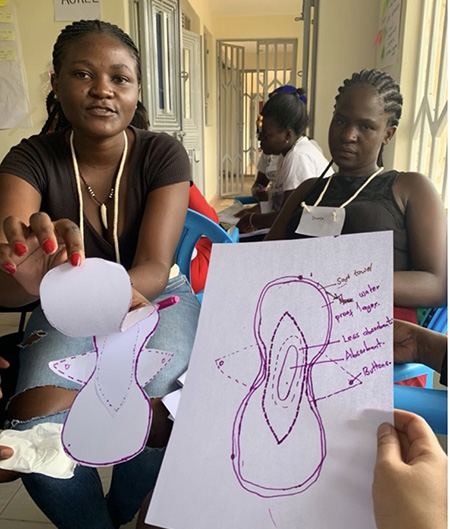
Reflections
The week was over before I knew it but the opportunity to be with a project from inception to implementation to revision has been an incredible learning experience. I had the opportunity to work with so many inspiring and passionate people and am still in awe of the vulnerability and strength of the girls who participated in the workshop as well as the trainers who embraced and breathed life into the curriculum.

